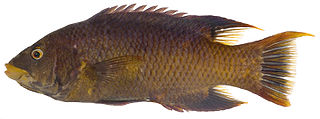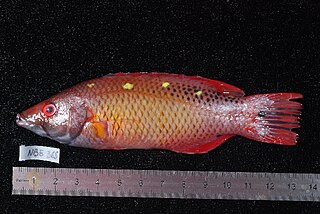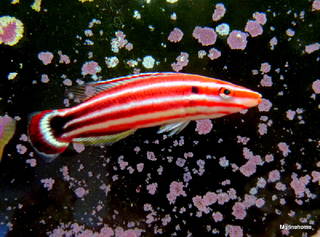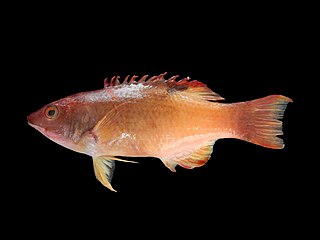
The red pigfish, also known as the red hogfish or eastern pigfish, is a species of wrasse native to the southwestern Pacific Ocean from eastern Australia to New Zealand, including Lord Howe Island, Norfolk Island, and the Kermadec Islands. It inhabits reefs and offshore waters, where it occurs from the surface to 60 m (200 ft) deep. Males of this species can reach a length of 50 cm (20 in), while females only reach 30 cm (12 in).

Bodianus or the hogfishes is a genus of fish in the family Labridae found in the Atlantic, Indian and Pacific Ocean. These species have many parasites.

The Spanish hogfish, Bodianus rufus, is a species of wrasse native to the western Atlantic Ocean, where it can be found from North Carolina and Bermuda through the Caribbean and the Gulf of Mexico to southern Brazil. It inhabits coral or rock reefs at depths of 1 to 70 m. While the adults feed on such prey as molluscs, crustaceans, echinoderms, worms, and small fish, the juveniles act as cleaner fishes. This species can reach a length of 40 cm (16 in), though most do not exceed 28 cm (11 in). This species is of minor importance to local commercial fisheries and can be found in the aquarium trade. When Marcus Elieser Bloch named the genus Bodianus he used Bodianus bodianus as the type species of the genus, this is a junior synonym of Bodianus rufus.

The barred hogfish is a species of wrasse native to the eastern Atlantic Ocean, where it occurs around the Macaronesian island groups of the Azores, Madeira, the Canary Islands and Cape Verde. This species occurs on rocky reefs at depths of 20 to 200 m. It can reach a length of 43 cm (17 in), though most do not exceed 30 cm (12 in). It is of minor importance to local commercial fisheries. This species was formally described as Labrus scrofa in 1839 by Achille Valenciennes with the type locality given as the Cape Verde Islands.

Bodianus mesothorax, the split-level hogfish, blackbelt hogfish, black-belt hogfish, coral hogfish, eclipse hogfish, eclipse pigfish, mesothorax hogfish or yellow-spotted hogfish, is a species of wrasse native to the western Pacific Ocean and the eastern Indian Ocean.

The spotfin hogfish or Cuban hogfish is a species of wrasse native to the Atlantic Ocean, where it is mainly found from North Carolina, United States, through the Caribbean to Brazil. It has also been recorded from São Tomé off the coast of Africa. This species inhabits reefs, both rock and coral, where it occurs at depths of 15 to 120 m though rarely deeper than 24 m (79 ft). This species can reach a length of 28.5 cm (11.2 in), though most do not exceed 18 cm (7.1 in). It is of minor importance to local commercial fisheries and can be found in the aquarium trade.

Bodianus bilunulatus, the tarry hogfish, is a species of wrasse native to the Indian Ocean from the African coast to the western Pacific Ocean to Japan, New Caledonia, and the Philippines.

Diana's hogfish, Bodianus diana, is a species of wrasse native to the Indian Ocean from the African coast to the Nicobars and the Cocos-Keeling Islands. Reports of its presence in the western Pacific Ocean are erroneous. It occurs on the seaward side of reefs at depths from 6 to 50 m. It can reach a length of 16.9 cm (6.7 in). This species is of minor importance to local commercial fisheries and is found in the aquarium trade.

The twospot hogfish is a species of wrasse native to the Indo-Pacific from Madagascar to New Caledonia and from Japan to New Zealand. This species prefers areas of reefs with substrates of rubble or sand at depths from 30 to 60 m. This species can reach a length of 10 cm (3.9 in). It can be found in the aquarium trade.

Bodianus axillaris, the axilspot hogfish, coral pigfish or turncoat hogfish, is a species of wrasse native to the Indo-Pacific.

The Mexican hogfish, Bodianus diplotaenia, is a species of wrasse native to the eastern Pacific Ocean. Adults inhabit rocky or coral areas at depths of 5–75 m. Sometimes, they are also found on sandy bottoms and where marine plants abound. They are solitary or form aggregations of only a few individuals. Mexican hogfish feed on crabs, brittle stars, mollusks, and sea urchins. At night, they gather in cracks and crevices of rocks and caves to sleep. The Mexican hogfish starts life as a female, and later becomes a functional male. Males defend temporary reproductive territories called leks. The sex change may be due to local social conditions, but it may also have a genetic component, since the reversal occurs over a limited size range. They are oviparous, with distinct pairing during breeding.

The crescent-tail hogfish, also known as the candy cane hogfish or Pacific redstriped hogfish, is a species of wrasse native to the Pacific Ocean from Sulawesi to the Line Islands. It can be found in groups at depths from 20 to 75 m. This species can reach 8.7 cm (3.4 in) in standard length. Juveniles are white and black. Adults are white with four broad red stripes, suffused with black on caudal peduncle and caudal fin. It can be found in the aquarium trade.

Bodianus neilli, the Bay of Bengal hogfish, is a species of wrasse in the family Labridae. It is found in the Indian Ocean in reefs off the coasts of the Maldives, Sri Lanka, India, Myanmar and Thailand, although records from the Maldives are doubtful. Bodianus neilli was described as Cossyphus neilli in 1867 by Francis Day with the type locality given as Madras.
Bodianus solatus, the sunburnt hogfish, is a species of wrasse native to tropical and warm temperate waters of Western Australia. It was formerly considered the western Australian form of the goldspot hogfish.
Bodianus rubrisos, the red-sashed hogfish or morsecode pigfish, is a species of wrasse native to tropical and warm temperate waters of the Indo-West Pacific, particularly Japan, Taiwan and Indonesia. It has been recorded off Australia at Scott Reef in Western Australia and in the Arafura Sea off the Northern Territory.
Bodianus paraleucosticticus, the five-striped hogfish, is a species of wrasse native to tropical and warm temperate waters of the Indo-West Pacific, particularly Papua New Guinea, New Caledonia and Rarotonga. It has also been recorded at Holmes Reef in the Coral Sea off Queensland. The specific name is a compound of para meaning "near" with leucostictus meaning "white-spotted" referring to the close relationship of this species with Bodianus leucostictus.

Bodianus albotaeniatus, the Hawaiian hogfish, is a species of wrasse native to the Hawaiian Islands. This species occurs on reef slopes at depths of from 3 to 160 m with the adults being found in deeper waters than the juveniles. This species can reach 55 cm (22 in) in total length with a maximum recorded weight of 1.8 kg (4.0 lb). It is of minor importance to local commercial fisheries and is also popular as a game fish. It can also be found in the aquarium trade.
Bodianus trilineatus, the fourline hogfish, is a species of wrasse found in the western Indian Ocean.
Bodianus opercularis, the blackspot hogfish, is a species of wrasse. It is found in the Indian Ocean, the Red Sea, the Gulf of Aqaba in the north to Madagascar and Mauritius in the south, and east to Christmas Island.
Bodianus leucosticticus, the lined hogfish, is a species of wrasse. It is found in the Indo-West Pacific.















